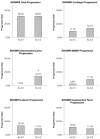Longitudinal assessment of MRI in hip osteoarthritis using SHOMRI and correlation with clinical progression
- PMID: 27162009
- PMCID: PMC4879061
- DOI: 10.1016/j.semarthrit.2016.04.001
Longitudinal assessment of MRI in hip osteoarthritis using SHOMRI and correlation with clinical progression
Abstract
Purpose: To assess the evolution of MR imaging findings in normal volunteers and subjects with hip osteoarthritis (OA) over 1.5 years described by the semi-quantitative Scoring Hip OA with MRI (SHOMRI) scoring system and their correlation with the evolution of clinical parameters.
Materials and methods: Hip MRI studies of 18 subjects with [Kellgren-Lawrence (KL) score = 2/3; mean age = 54.4 ± 11.2 years; 27.8% women] and 36 controls without radiographic OA [KL = 0/1; mean age = 43.7 ± 12.8 years; 50.0% women] were assessed at baseline and after 1.5 years by using SHOMRI, and their clinical status was evaluated by using Harris Hip Score and Hip Disability and Osteoarthritis Outcome Score (HOOS). Imaging and clinical parameters at baseline and their change over time were compared between groups using Mann-Whitney U and Fisher׳s exact tests. Spearman׳s rank correlations and generalized linear models adjusted for age, sex, BMI, and KL were used to assess associations between imaging and clinical findings.
Results: At baseline, OA subjects had significantly higher SHOMRI total scores than controls [median (IQR): 12.5 (6-19.5) vs. 7 (4-13.5); p = 0.024]. Over 1.5 years, only the progression rate of subchondral cysts was significantly higher in OA subjects than in controls (16.7% vs. 0.0%; p = 0.033), while no significant differences were found for any of the other SHOMRI subscales. Baseline bone-marrow edema pattern (BMEP) was significantly associated with worsening pain (HOOS subscale; p = 0.018) and hip-related quality of life (HOOS subscale; p = 0.044). Progression of subchondral cysts was significantly associated with worsening symptoms other than pain (HOOS subscale, p = 0.030). Baseline KL did not significantly correlate with worsening of any clinical symptoms (each, p > 0.05).
Conclusion: In this relatively young study population without or with mild to moderate radiographic hip OA, only minimal differences were found between groups regarding the progression of hip abnormalities as assessed by SHOMRI over 1.5 years. However, BMEP predicted clinical worsening and subchondral cyst progression was associated with worsening symptoms. Although longer follow-up periods are required, this suggests that SHOMRI is a useful tool to monitor hip abnormalities and their progression longitudinally.
Keywords: HOOS; Hip bone marrow edema pattern; Hip cartilage; Hip imaging; Hip osteoarthritis; Hip pain; Magnetic resonance imaging; SHOMRI; Semi-quantitative scoring.
Copyright © 2016 Elsevier Inc. All rights reserved.
Figures


Similar articles
-
Scoring hip osteoarthritis with MRI (SHOMRI): A whole joint osteoarthritis evaluation system.J Magn Reson Imaging. 2015 Jun;41(6):1549-57. doi: 10.1002/jmri.24722. Epub 2014 Aug 20. J Magn Reson Imaging. 2015. PMID: 25139720 Free PMC article.
-
Association of cartilage defects, and other MRI findings with pain and function in individuals with mild-moderate radiographic hip osteoarthritis and controls.Osteoarthritis Cartilage. 2013 Nov;21(11):1685-92. doi: 10.1016/j.joca.2013.08.009. Epub 2013 Aug 12. Osteoarthritis Cartilage. 2013. PMID: 23948977 Free PMC article.
-
Using the Scoring Hip Osteoarthritis with Magnetic Resonance Imaging (SHOMRI) system to assess intra-articular pathology in femoroacetabular impingement.J Orthop Res. 2018 Nov;36(11):3064-3070. doi: 10.1002/jor.24102. Epub 2018 Jul 13. J Orthop Res. 2018. PMID: 29947434 Free PMC article. Clinical Trial.
-
The relationship between MRI-detected hip abnormalities and hip pain in hip osteoarthritis: a systematic review.Rheumatol Int. 2024 Oct;44(10):1887-1896. doi: 10.1007/s00296-024-05678-2. Epub 2024 Aug 13. Rheumatol Int. 2024. PMID: 39136786 Free PMC article.
-
Bone marrow lesions in osteoarthritis: biomarker or treatment target? A narrative review.Skeletal Radiol. 2025 Feb;54(2):175-191. doi: 10.1007/s00256-024-04725-0. Epub 2024 Jun 14. Skeletal Radiol. 2025. PMID: 38877110 Review.
Cited by
-
RADIOGRAPHIC HIP OSTEOARTHRITIS IS PREVALENT, AND IS RELATED TO CAM DEFORMITY 12-24 MONTHS POST-HIP ARTHROSCOPY.Int J Sports Phys Ther. 2018 Apr;13(2):177-184. Int J Sports Phys Ther. 2018. PMID: 30090676 Free PMC article.
-
iPhone Sensors in Tracking Outcome Variables of the 30-Second Chair Stand Test and Stair Climb Test to Evaluate Disability: Cross-Sectional Pilot Study.JMIR Mhealth Uhealth. 2017 Oct 27;5(10):e166. doi: 10.2196/mhealth.8656. JMIR Mhealth Uhealth. 2017. PMID: 29079549 Free PMC article.
-
Prevalence of early hip OA features on MRI in high-impact athletes. The femoroacetabular impingement and hip osteoarthritis cohort (FORCe) study.Osteoarthritis Cartilage. 2021 Mar;29(3):323-334. doi: 10.1016/j.joca.2020.12.013. Epub 2020 Dec 30. Osteoarthritis Cartilage. 2021. PMID: 33387651 Free PMC article.
-
Patient-reported outcome measures in osteoarthritis: a systematic search and review of their use and psychometric properties.RMD Open. 2018 Dec 16;4(2):e000715. doi: 10.1136/rmdopen-2018-000715. eCollection 2018. RMD Open. 2018. PMID: 30622735 Free PMC article.
-
Radiographic evaluation of the painful adolescent and young adult hip.J Pediatr Soc North Am. 2024 Apr 3;7:100039. doi: 10.1016/j.jposna.2024.100039. eCollection 2024 May. J Pediatr Soc North Am. 2024. PMID: 40433291 Free PMC article. Review.
References
-
- Helmick CG, Felson DT, Lawrence RC, et al. Estimates of the prevalence of arthritis and other rheumatic conditions in the United States. Part I. Arthritis Rheum. 2008;58:15–25. - PubMed
-
- Nho SJ, Kymes SM, Callaghan JJ, Felson DT. The burden of hip osteoarthritis in the United States: epidemiologic and economic considerations. J Am Acad Orthop Surg. 2013;21(Suppl 1):S1–6. - PubMed
-
- Philippon MJ, Stubbs AJ, Schenker ML, Maxwell RB, Ganz R, Leunig M. Arthroscopic management of femoroacetabular impingement: osteoplasty technique and literature review. Am J Sports Med. 2007;35:1571–1580. - PubMed
Publication types
MeSH terms
Grants and funding
LinkOut - more resources
Full Text Sources
Other Literature Sources
Medical

